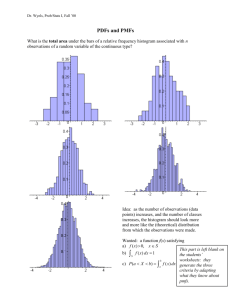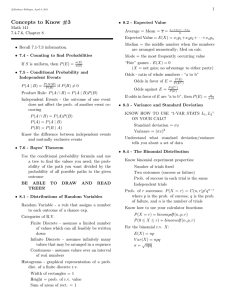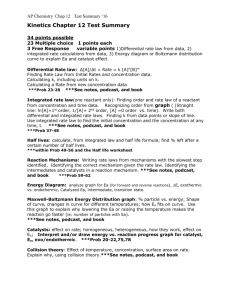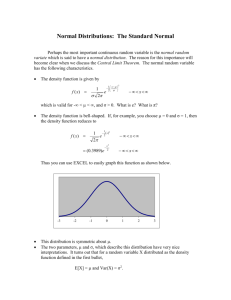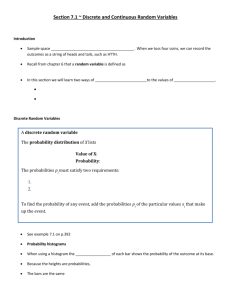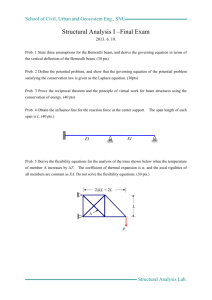Probability Theory and the use of the Normal Curve.
advertisement
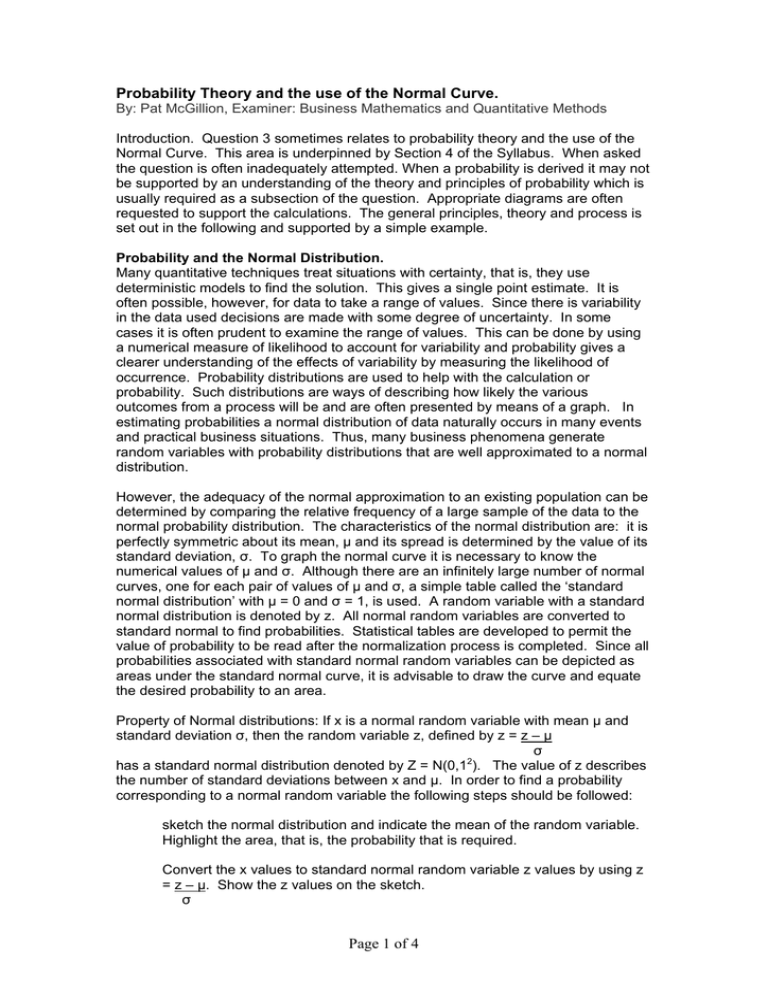
Probability Theory and the use of the Normal Curve. By: Pat McGillion, Examiner: Business Mathematics and Quantitative Methods Introduction. Question 3 sometimes relates to probability theory and the use of the Normal Curve. This area is underpinned by Section 4 of the Syllabus. When asked the question is often inadequately attempted. When a probability is derived it may not be supported by an understanding of the theory and principles of probability which is usually required as a subsection of the question. Appropriate diagrams are often requested to support the calculations. The general principles, theory and process is set out in the following and supported by a simple example. Probability and the Normal Distribution. Many quantitative techniques treat situations with certainty, that is, they use deterministic models to find the solution. This gives a single point estimate. It is often possible, however, for data to take a range of values. Since there is variability in the data used decisions are made with some degree of uncertainty. In some cases it is often prudent to examine the range of values. This can be done by using a numerical measure of likelihood to account for variability and probability gives a clearer understanding of the effects of variability by measuring the likelihood of occurrence. Probability distributions are used to help with the calculation or probability. Such distributions are ways of describing how likely the various outcomes from a process will be and are often presented by means of a graph. In estimating probabilities a normal distribution of data naturally occurs in many events and practical business situations. Thus, many business phenomena generate random variables with probability distributions that are well approximated to a normal distribution. However, the adequacy of the normal approximation to an existing population can be determined by comparing the relative frequency of a large sample of the data to the normal probability distribution. The characteristics of the normal distribution are: it is perfectly symmetric about its mean, μ and its spread is determined by the value of its standard deviation, σ. To graph the normal curve it is necessary to know the numerical values of μ and σ. Although there are an infinitely large number of normal curves, one for each pair of values of μ and σ, a simple table called the ‘standard normal distribution’ with μ = 0 and σ = 1, is used. A random variable with a standard normal distribution is denoted by z. All normal random variables are converted to standard normal to find probabilities. Statistical tables are developed to permit the value of probability to be read after the normalization process is completed. Since all probabilities associated with standard normal random variables can be depicted as areas under the standard normal curve, it is advisable to draw the curve and equate the desired probability to an area. Property of Normal distributions: If x is a normal random variable with mean μ and standard deviation σ, then the random variable z, defined by z = z – μ σ 2 has a standard normal distribution denoted by Z = N(0,1 ). The value of z describes the number of standard deviations between x and μ. In order to find a probability corresponding to a normal random variable the following steps should be followed: sketch the normal distribution and indicate the mean of the random variable. Highlight the area, that is, the probability that is required. Convert the x values to standard normal random variable z values by using z = z – μ. Show the z values on the sketch. σ Page 1 of 4 Using the Normal tables, find the area corresponding to the z values. The symmetry of the normal distribution can be used to find areas corresponding to negative z values. It should be noted that different Normal tables may be used – the most common either reading from the centre of the distribution or the left side tail; the tables used in this example are provided by the Institute at examinations and are available upon request. To demonstrate the use of probability distributions, the following example is used: Example: CPA Distributors has a policy of cash payment. It has recently revised this policy to cater for larger customers with a good credit rating who purchase bulk volumes of goods. The auditors report that the mean time between sending an invoice and receiving payment is 20 days with a standard deviation of 5 days. Assuming that the distribution is normally distributed (i) Find the probability that a bill will not be paid until after 25 days; (ii) If 2000 bills were issued, what percentage would be paid in less than 10 days? (iii) From 2000 bills how many would you expect to be paid between 15 and 21 days? (i) Transform the 25 days from X = (20, 52) to Z = N(0, 12) z = x – μ = 25 – 20 = 1 σ 5 From the tables at z = 1, probability = 0.8413 The prob (x > 25) = prob (z > 1) = 1 – 0.8413 = 0.1587, represented by the shaded area in the diagram. Therefore, the probability that a bill will not be paid until after 25 days is 16%. Page 2 of 4 (ii) Transforming the 10 days from X to Z; z = x – μ = 10 – 20 = -2 σ 5 Prob (x, 10) = Prob (z, -2); from tables at z = -2, prob = 1 – 0.9773 = 0.0227, represented by the shaded area in the diagram. That is, the expected number of bills paid within 10 days is 2000 x 0.0227 = 45. (iii) Transforming the 15 and 21 days from X to Z: (x = 15) z = x – μ = 15 – 20 = -1; σ 5 (x = 21) z = x – μ = 21 – 20 = 0.2 σ 5 Prob (15 < x < 21) = Prob (-1 < z < 1.2), represented by the shaded area in the diagram. Page 3 of 4 This area, and the probabilities, are found by: (a) (b) (c) 1 – area in tail at z = 1, that is, 1 – 0.8413 = 0.1587 Area at z = 0.2, that is, 0.5793 Required area is 0.5793 – 0.1587 = 0.4206 The expected number of bills paid between 15 and 21 days is 2000 x 0.4206 = 841, Page 4 of 4
